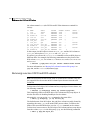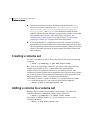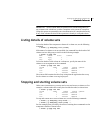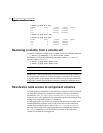
362 Creating and administering volume sets
Creating a volume set
■ Volume sets can be used in place of volumes with the following vxsnap
operations on instant snapshots:
addmir, dis, make, prepare, reattach,
refresh, restore, rmmir, split, syncpause, syncresume, syncstart,
syncstop, syncwait, and unprepare. The third-mirror break-off usage
model for full-sized instant snapshots is supported for volume sets provided
that sufficient plexes exist for each volume in the volume set. See
“Administering volume snapshots” on page 303 and “Creating instant
snapshots of volume sets” on page 334 for more information.
■ A full-sized snapshot of a volume set must itself be a volume set with the
same number of volumes and the same volume index numbers as the parent.
The corresponding volumes in the parent and snapshot volume sets are also
subject to the same restrictions as apply between standalone volumes and
their snapshots.
Creating a volume set
To create a volume set for use by Veritas File System (VxFS), use the following
command:
# vxvset [-g diskgroup] -t vxfs make volset volume
Here volset is the name of the volume set, and volume is the name of the first
volume in the volume set. The
-t option defines the content handler
subdirectory for the application that is to be used with the volume. This
subdirectory contains utilities that an application uses to operate on the volume
set. As the operation of these utilities is determined by the requirements of the
application and not by VxVM, it is not discussed further here.
For example, to create a volume set named myvset that contains the volume
vol1, in the disk group mydg, you would use the following command:
# vxvset -g mydg -t vxfs make myvset vol1
Adding a volume to a volume set
Having created a volume set containing a single volume, you can use the
following command to add further volumes to the volume set:
# vxvset [-g diskgroup] [-f] addvol volset volume
For example, to add the volume vol2, to the volume set myvset, use the
following command:
# vxvset -g mydg addvol myvset vol2


















